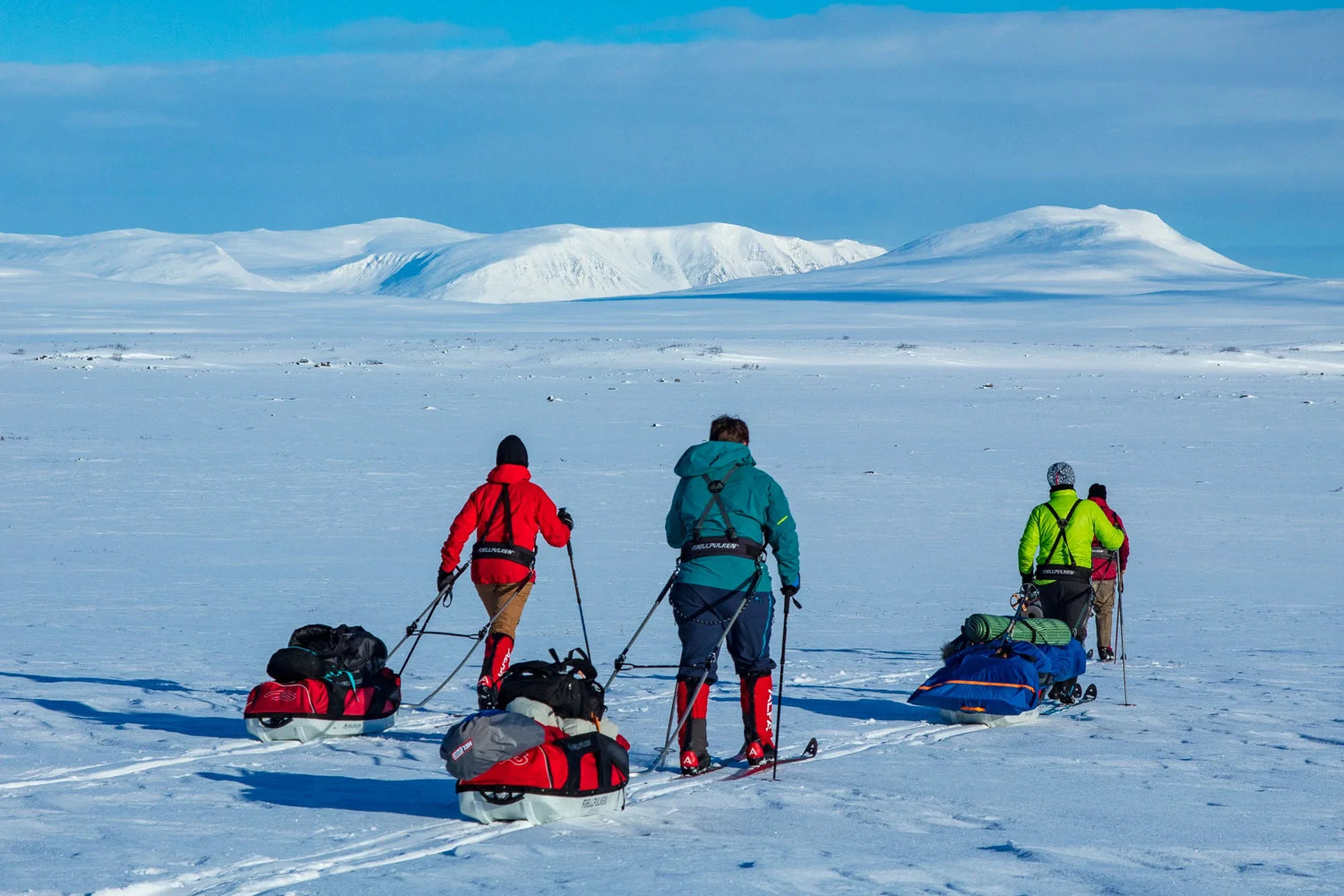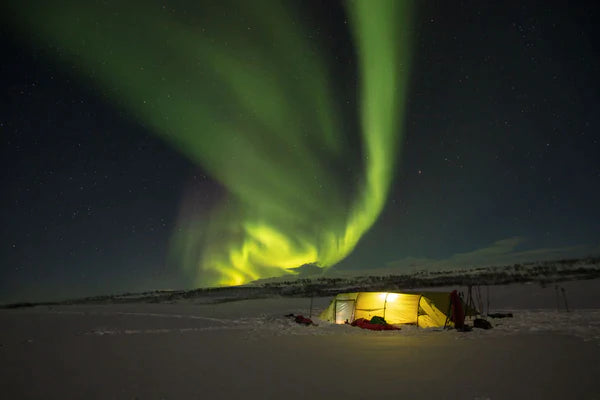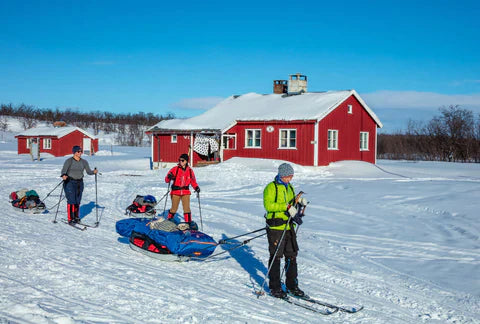Arctic Norway: Ski Touring
Have you ever harboured dreams of arctic exploration, or wondered what it would be like to trek to the poles? Many of us are enchanted by the idea, but have never spared it much thought because the reality seems just too extreme.

Trip Summary
Time: 7 days
Distance: 90km / 56 miles
Total Ascent: 1,200m / 3,940ft
Highest Point: 600m / 1,970ft
Difficulty Level: Demanding
Have you ever harboured dreams of arctic exploration, or wondered what it would be like to trek to the poles? Many of us are enchanted by the idea, but have never spared it much thought because the reality seems just too extreme.
Yet the arctic wilderness is not as inaccessible as you might think. Yes, you'll need to cross-country ski, but many people ski on a regular basis. So where should you go for your first arctic adventure?
Greenland and Svalbard are classic destinations, but best suited to experienced winter travellers. A more feasible option is Finnmark, at the northern extremity of Norway. At 70° north, this is well inside the arctic circle, yet still part of mainland Europe.
Exemplifying the region's wild, empty landscapes is the Finnmarksvidda Plateau. Encompassing 22,000 square kilometres (8,500 square miles) of gently undulating tundra, it offers perfect conditions for a multi-day ski tour.

Getting off the Beaten Track
Most crossings of Finnmarksvidda begin near Alta, on the coast, and finish inland at Karasjok. In winter, there are two main routes to chose from. First is an 80km snowmobile trail, broken by overnight stays in three mountain huts. Pretty scenery, but you'll be following a marked track where noisy snowmobiles and other skiers are a regular occurrence.
For a true wilderness experience, it's far more rewarding to devise your own route across the plateau. Snowmobiles are forbidden out here, so you'll be alone amid the pristine expanse. Most parties stay in the first and final mountain huts (Jotka and Ravnastua), diverting off-grid - east of the great lake of Iešjávri - in between. Expect to take six or seven days to complete this sort of cross-country itinerary.
Equipment and Weather
Of course solitude necessitates self-sufficiency. Like polar adventurers, you'll need to pull a pulk (arctic sled) packed with a tent, sleeping bag, stove and food. Many groups go properly Norwegian and add a husky dog or two for extra pulling power.
As well as expedition-quality equipment, you'll need specialist skills to survive in this beautiful yet unforgiving environment. The main challenge is keeping alive in the unrelenting cold. By March and April the 24-hour darkness is over, but night-time temperatures of -25°C, with -10°C during the day, remains commonplace. Wind ramps-up the chill factor significantly.
Guided Groups
In these conditions little things matter, because cold fingers can quickly escalate into a medical emergency. Razor-sharp navigation is essential too, given the often featureless landscape.
If you have the experience to travel safely and independently across this landscape, go for it. If not, consider joining a guided group. Some immensely experienced arctic guides operate here, all happy to share their knowledge and equipment, and lead even novice skiers across the plateau. They'll provide numerous small tips that not only make this environment survivable, but add a degree of comfort to your trip.
Given that you're properly prepared, get ready for the trip of a lifetime. This is a unique wilderness journey such as few have experienced, and the overall impression is of a vast, empty whiteness. Vegetation and wildlife are both scarce, but you're likely to meet at least some of the resident creatures, such as linx, foxes, reindeer, lemmings and ptarmigan.
Daily Practicalities
If you've never skied or pulled a pulk before, fear not; it's not rocket science and you'll pick it up fairly quickly. Hauling the pulk up steep slopes can be laborious, but there are countless possible routes across the plateau, and picking your terrain wisely is all part of the challenge.
An average day might consist of five hours active skiing. In crisp, sunny conditions, the views extend far and wide across the snow-clad void. In blizzards, your vision might be restricted to the back of the pulk in front. Having an organised system of clothing is essential; one or two layers may be sufficient to avoid overheating while you're moving, but a warm jacket is your first priority as soon as you stop.
Anything that gets damp or sweaty will freeze whether it's inside the tent or not, and it's interesting to discover how different products perform at sub-zero temperatures. Toothpaste, chocolate raisins, deodorant - which ones do you think freeze solid?
Picking good camp spots is a skill too. Deep snow facilitates pitching in a world where shovelled snow rather than pegs provide security, while the availability of fresh water greatly reduces the amount of fuel you'll need to burn. An ice drill lets you bore through lake surfaces to access drinking water below.

Auroral Magic
If the stark beauty of the landscape and the challenge of completing the journey are two of the main attractions, for most visitors a third incentive also beckons them this far north. The nocturnal magic of the aurora borealis. Finnmark lies directly beneath the auroral oval, and is renowned as one of the best places in the world to see the northern lights. You stand a good chance of seeing them on any clear night from October to early April.
By camping your way across Finnmarksvidda, far from any light pollution, you're maximising your chances of witnessing this natural wonder. There are many memorable aspects to completing an arctic adventure, but watching the sky come alive with natural neon lights after a day of wilderness skiing has got to be the best.
Practicalities
Getting There
The airport at Alta is handy for the start of the crossing; connecting flights land here from Oslo. From the end in Karasjok, the closest airports are Lakselv or Ivalo, in Finland. Bus services connect all these places by land, while taxis are best for getting to and from the trailheads.
When to Go
The main cross-country ski season is from mid-February to late April, with temperatures and daylight hours increasing the later it gets. Travel before 5th April if you want a chance of seeing the aurora borealis.
Accommodation
There are three serviced mountain lodges, or fjellstue, along the Finnmarksvidda snowmobile trail: Jotka (jotka.no), Mollisjok (www.mollisjok.com) and Ravnastua (www.ravnastua.no). They all offer rustic accommodation in dorm-style rooms for about US$46 per person. All have basic self-catering kitchens, while some offer cooked dinners for around US$50.
Guided Trips
Several companies run trips along the marked trail, travelling either by ski or snowmobile. For cross-country wilderness trips led by experienced arctic guides, contact the excellent local company Turgleder (www.turgleder.com, mail@turgleder.com | +47 908 55 556)
For more information about travelling and staying in Norway, see www.visitnorway.com
Our yak wool base layers and wool mid layers are perfect for adventures in the snow, possessing natural properties that promote both warmth and breathability.